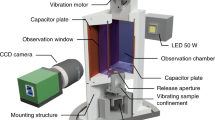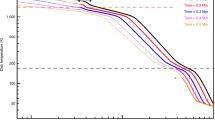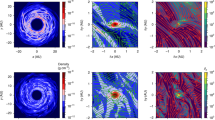Abstract
During the initial stages of planet formation in circumstellar gas disks, dust grains collide and build up larger and larger bodies1. How this process continues from metre-sized boulders to kilometre-scale planetesimals is a major unsolved problem2: boulders are expected to stick together poorly3, and to spiral into the protostar in a few hundred orbits owing to a ‘headwind’ from the slower rotating gas4. Gravitational collapse of the solid component has been suggested to overcome this barrier1,5,6. But even low levels of turbulence will inhibit sedimentation of solids to a sufficiently dense midplane layer2,7, and turbulence must be present to explain observed gas accretion in protostellar disks8. Here we report that boulders can undergo efficient gravitational collapse in locally overdense regions in the midplane of the disk. The boulders concentrate initially in transient high pressure regions in the turbulent gas9, and these concentrations are augmented a further order of magnitude by a streaming instability10,11,12 driven by the relative flow of gas and solids. We find that gravitationally bound clusters form with masses comparable to dwarf planets and containing a distribution of boulder sizes. Gravitational collapse happens much faster than radial drift, offering a possible path to planetesimal formation in accreting circumstellar disks.
This is a preview of subscription content, access via your institution
Access options
Subscribe to this journal
Receive 51 print issues and online access
$199.00 per year
only $3.90 per issue
Buy this article
- Purchase on Springer Link
- Instant access to full article PDF
Prices may be subject to local taxes which are calculated during checkout



Similar content being viewed by others
References
Safronov, V. S. Evolution of the Protoplanetary Cloud and Formation of Earth and the Planets (NASA Tech. Transl. F-677, Jerusalem, 1972); translation of Evoliutsiia Doplanetnogo Oblaka (Nauka, Moscow, 1969)
Dominik, C., Blum, J., Cuzzi, J. N. & Wurm, G. in Protostars and Planets V (eds Reipurth, B., Jewitt, D. & Keil, K.) 783–800 (Univ. Arizona Press, Tucson, 2007)
Benz, W. Low velocity collisions and the growth of planetesimals. Space Sci. Rev. 92, 279–294 (2000)
Weidenschilling, S. J. Aerodynamics of solid bodies in the solar nebula. Mon. Not. R. Astron. Soc. 180, 57–70 (1977)
Goldreich, P. & Ward, W. R. The formation of planetesimals. Astrophys. J. 183, 1051–1062 (1973)
Youdin, A. N. & Shu, F. H. Planetesimal formation by gravitational instability. Astrophys. J. 580, 494–505 (2002)
Weidenschilling, S. J. & Cuzzi, J. N. in Protostars and Planets III (eds Levy, E. H. & Lunine, J. I.) 1031–1060 (Univ. Arizona Press, Tucson, 1993)
Hartmann, L. Accretion Processes in Star Formation (Cambridge Astrophysics Series No. 32, Cambridge Univ. Press, Cambridge, UK, 1998)
Johansen, A., Klahr, H. & Henning, T. Gravoturbulent formation of planetesimals. Astrophys. J. 636, 1121–1134 (2006)
Youdin, A. N. & Goodman, J. Streaming instabilities in protoplanetary disks. Astrophys. J. 620, 459–469 (2005)
Johansen, A., Henning, T. & Klahr, H. Dust sedimentation and self-sustained Kelvin-Helmholtz turbulence in protoplanetary disk midplanes. Astrophys. J. 643, 1219–1232 (2006)
Johansen, A. & Youdin, A. Protoplanetary disk turbulence driven by the streaming instability: Nonlinear saturation and particle concentration. Astrophys. J. 662, 627–641 (2007)
Cuzzi, J. N., Dobrovolskis, A. R. & Champney, J. M. Particle-gas dynamics in the midplane of a protoplanetary nebula. Icarus 106, 102–134 (1993)
Balbus, S. A. & Hawley, J. F. Instability, turbulence, and enhanced transport in accretion disks. Rev. Mod. Phys. 70, 1–53 (1998)
Barge, P. & Sommeria, J. Did planet formation begin inside persistent gaseous vortices? Astron. Astrophys. 295, L1–L4 (1995)
Fromang, S. & Nelson, R. P. On the accumulation of solid bodies in global turbulent protoplanetary disc models. Mon. Not. R. Astron. Soc. 364, L81–L85 (2005)
Rice, W. K. M., Lodato, G., Pringle, J. E., Armitage, P. J. & Bonnell, I. A. Planetesimal formation via fragmentation in self-gravitating protoplanetary discs. Mon. Not. R. Astron. Soc. 372, L9–L13 (2006)
Cuzzi, J. N., Hogan, R. C., Paque, J. M. & Dobrovolskis, A. R. Size-selective concentration of chondrules and other small particles in protoplanetary nebula turbulence. Astrophys. J. 546, 496–508 (2001)
Hockney, R. W. & Eastwood, J. W. Computer Simulation Using Particles (McGraw-Hill, New York, 1981)
Gammie, C. F. Nonlinear outcome of gravitational instability in cooling, gaseous disks. Astrophys. J. 553, 174–183 (2001)
Gammie, C. F. Layered accretion in T Tauri disks. Astrophys. J. 457, 355–362 (1996)
Tanga, P., Weidenschilling, S. J., Michel, P. & Richardson, D. C. Gravitational instability and clustering in a disk of planetesimals. Astron. Astrophys. 427, 1105–1115 (2004)
Salo, H. Gravitational wakes in Saturn’s rings. Nature 359, 619–621 (1992)
Boss, A. P. Giant planet formation by gravitational instability. Science 276, 1836–1839 (1997)
Mayer, L., Quinn, T., Wadsley, J. & Stadel, J. Formation of giant planets by fragmentation of protoplanetary disks. Science 298, 1756–1759 (2002)
Weidenschilling, S. J. Can gravitational instability form planetesimals? Icarus 116, 433–435 (1995)
Dullemond, C. P. & Dominik, C. Dust coagulation in protoplanetary disks: A rapid depletion of small grains. Astron. Astrophys. 434, 971–986 (2005)
Weidenschilling, S. J. The origin of comets in the solar nebula: A unified model. Icarus 127, 290–306 (1997)
Throop, H. B. & Bally, J. Can photoevaporation trigger planetesimal formation? Astrophys. J. 623, L149–L152 (2005)
Haghighipour, N. & Boss, A. P. On pressure gradients and rapid migration of solids in a nonuniform solar nebula. Astrophys. J. 583, 996–1003 (2003)
Acknowledgements
This collaboration was made possible through the support of the Annette Kade Graduate Student Fellowship Program at the American Museum of Natural History. J.S.O. was supported by the US National Science Foundation, as was M.-M.M.L. in part. We thank J. Cuzzi for discussion about the role of cooling in the gravitational collapse.
Author information
Authors and Affiliations
Corresponding author
Ethics declarations
Competing interests
Reprints and permissions information is available at www.nature.com/reprints. The authors declare no competing financial interests.
Supplementary information
Supplementary Information
This file contains Supplementary Discussion; Supplementary Notes with Supplementary Figures 1-27 and additional references. (PDF 1763 kb)
Supplementary Video
This file contains Supplementary Video 1. The video follows the column density of dust particles from the onset of self-gravity (at t=0) to where gravitationally bound clumps have formed. The inset shows an enlargement around the densest point in the simulation. Clear accretion features are visible as the clump attracts solid material from the surroundings. (MOV 9878 kb)
Rights and permissions
About this article
Cite this article
Johansen, A., Oishi, J., Low, MM. et al. Rapid planetesimal formation in turbulent circumstellar disks. Nature 448, 1022–1025 (2007). https://doi.org/10.1038/nature06086
Received:
Accepted:
Issue Date:
DOI: https://doi.org/10.1038/nature06086
This article is cited by
-
The accretion of planet Earth
Nature Reviews Earth & Environment (2022)
-
Direct measurement of decimetre-sized rocky material in the Oort cloud
Nature Astronomy (2022)
-
AMBITION – comet nucleus cryogenic sample return
Experimental Astronomy (2022)
-
Understanding planet formation using microgravity experiments
Nature Reviews Physics (2021)
Comments
By submitting a comment you agree to abide by our Terms and Community Guidelines. If you find something abusive or that does not comply with our terms or guidelines please flag it as inappropriate.



